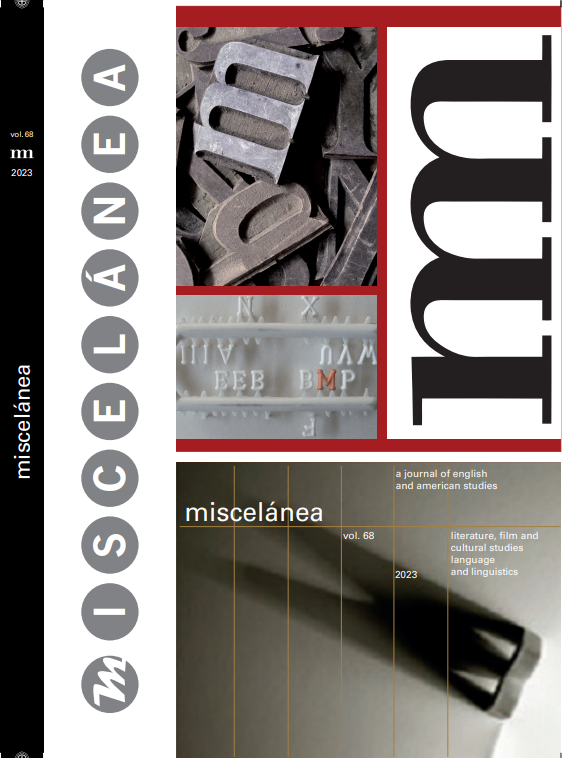Jurassic World: Fallen Kingdom as a 21st-Century Gothic Tale
An Antispeciesist Revision of Monstrosity
DOI:
https://doi.org/10.26754/ojs_misc/mj.20237347Keywords:
Jurassic World, Jurassic Park, Gothic film, monster film, antispeciesismAbstract
This paper considers Juan Antonio Bayona’s 2018 film Jurassic World: Fallen Kingdom as a Gothic film which disrupts the archetypal conventions of monster films, especially in relation to the antispeciesist conception of monsters —in this case, the genetically-engineered dinosaurs which feature in the Jurassic Park and Jurassic World sagas. Through an analysis of its cinematography, character construction, scenarios and plot development in the light of Gothic Studies, I will argue that this film is not just Gothic in appearance, but also in the sense that it
breaks with contemporary anthropocentric conventions of normalcy, unity and species boundaries, and that it confirms the trend in filmic narratives that takes into account the monsters’ perspectives in order to challenge human exceptionalism.
Downloads
References
Adams , Carol. (1990) 2015. The Sexual Politics of Meat - 25th Anniversary Edition: A Feminist-Vegetarian Critical Theory. New York: Bloomsbury Publishing.
Aldana Reyes, Xavier. 2020. Gothic Cinema. London and New York: Routledge.
Bayona, Juan Antonio. 2018. Jurassic World: Fallen Kingdom. Universal Pictures.
Braidotti , Rosi. 2013. The Posthuman. New Jersey: John Wiley and Sons.
Bruhm, Steven. 2002. “The Contemporary Gothic: Why we Need it”. In Hogle, Jerrold E. (ed.): 259-276.
Cohen, Jeffrey Jerome. 1996. Monster Theory: Reading Culture. Minnesota: University of Minnesota Press.
Curtis , Barry. 2008. Dark Places: The Haunted House in Film. London: Reaktion Books.
Deckard, Sharae. 2019. “Ecogothic”. In Aldana Reyes, Xavier and Maisha Weister (eds.) Twenty-First-Century Gothic: An Edinburgh Companion. Edinburgh: Edinburgh U.P.
Fischer, Bob. 2021. Animal Ethics: A Contemporary Introduction. New York: Routledge.
Fisher, Kenn. 2014. “Decline of the Meatosaurus”. In Michaud, Nicolas and Jessica Watkins (eds.) Jurassic Park and Philosophy: The Truth Is Terrifying. Chicago: Open Court.
Ford Coppola, Francis. 1992. Bram Stoker’s Dracula. Columbia Pictures.
Grazier, Kevin R. 2008. The Science of Michael Crichton: An Unauthorized Exploration into the
Real Science behind the Fictional Worlds of Michael Crichton. Dallas: BenBella Books.
Gregersdotter , Katarina, Nicklas Hållén and Johan Höglund. 2015. “Introduction”. In Gregersdotter, Katarina, Nicklas Hållén and Johan Höglund (eds.) Animal Horror Cinema: Genre, History and Criticism. London: Palgrave Macmillan: 1-18.
Gruen, Lori. 2012. Ethics and Animals: An Introduction. Cambridge: Cambridge U.P.
Halberstam , Jack. 1995. Skin Shows: Gothic Horror and the Technology of Monsters. London: Duke U.P.
Hand, Richard J. and Jay McRoy. 2020. “Introduction”. In Hand, Richard J. and Jay McRoy (eds.) Gothic Film. An Edinburgh Companion. Edinburgh: Edinburgh U.P.: 1-7.
Hitchcock, Alfred. 1940. Rebecca. Selznick International Pictures.
Hogle, Jerrold E. (ed.) 2002. The Cambridge Companion to Gothic Fiction. Cambridge: Cambridge U.P.
Hogle , Jerrold E. 2002. “Introduction: the Gothic in Western Culture”. In Hogle, Jerrold E. (ed.):1-20.
Kavka, Misha. 2002. “The Gothic on Screen”. In Hogle, Jerrold E. (ed.): 209-228.
Khapae va, Dina. 2019. “Eaten in Jurassic World: Antihumanism in Popular Culture”. In Khapaeva,
Dina (ed.) Man-Eating Monsters: Anthropocentrism and Popular Culture. Bingley: Emerald Publishing: 15-34.
Milbank, Alison. 1998. “Female Gothic”. In Mulvey-Roberts, Marie (ed.) The Handbook to Gothic Literature. New York: New York U.P.: 53-57.
Moers, Ellen. 1976. Literary Women. New York: Anchor Books.
Murnau , Friedrich Wilhelm. 1922. Nosferatu, eine Symphonie des Grauens. Kino Lorber.
Parry, Geraint. 2015. “Jurassic World: Just How Impossible Is it?” The Biochemist 37 (6): 18-21. <https://doi.org/10.1042/BIO03706018>.
Shildrick, Margrit. 2002. Embodying the Monster. Encounters with the Vulnerable Self. London: Sage.
Smith, Andrew and William Hughes. 2013. EcoGothic. Manchester and New York: Manchester U.P.
Suvin, Darko. 1979. Metamorphoses of Science Fiction: On the Poetics and History of a Literary Genre. New Haven and London: Yale U.P.
Vidler, Anthony. 1994. The Architectural Uncanny: Essays in the Modern Unhomely. Cambridge, Massachusetts and London: MIT Press.
Wallace , Diana and Andrew Smith. 2009. The Female Gothic: New Directions. New York: Springer.
Wise, Robert. 1963. The Haunting. Metro-Goldwyn-Mayer.
Wolfe, Cary. 2009. What Is Posthumanism? Minneapolis: University of Minnesota Press.
Wright, Laura. 2015. The Vegan Studies Project: Food, Animals, and Gender in the Age of Terror. Athens, Georgia and London: University of Georgia Press.
Downloads
Published
How to Cite
Issue
Section
License
Copyright (c) 2023 Xiana Vázquez Bouzó

This work is licensed under a Creative Commons Attribution-NonCommercial 4.0 International License.
Accepted 2023-10-04
Published 2023-12-19


